 VOICE Home Page: http://www.os2voice.org |
[Newsletter Index] |
 VOICE Home Page: http://www.os2voice.org |
[Newsletter Index] |
|
By Michal
Necasek © August 2001 |
In the last issue I provided a brief description of the wonders offered by Microsoft/IBM
Operating System/2 version 1.3, the last 16-bit version of OS/2, released ten years
ago. This time I will again set out on a journey against the course of time
and take a look at the OS/2 developments that took place in 1988-1990.
HPFS was designed from the ground up by Gordon Letwin, Chief Architect of OS/2
at Microsoft. This new filesystem overcame pretty much all the annoying limitations
of the FAT filesystem. Among the major features of HPFS were:
It is interesting that FAT was known to be more of a liability than an asset
even in the 1980's but Microsoft is still selling it with its Windows 9x line many
years later (an eternity in computer time). They have removed some capacity and
naming limitations but other problems such as extremely low damage resistance remain
completely unaddressed. The problem with FAT is that it was designed for floppies
- it was developed by Bill Gates and Marc McDonald in 1977. "When applied to
fixed disks, however, the FAT began to look more like a bug than a feature",
to quote an article by Ray Duncan (author of several excellent books on DOS and
OS/2 programming) published in September, 1989 issue of Microsoft Systems Journal.
But let's get back on topic. OS/2 1.2 also had a new look and feel - which happened
to be the same as in OS/2 1.3. Hence I didn't make quite as many screenshots as
last time because I would only repeat myself. It is perhaps useful to note that
this look and feel was nearly identical to that of Windows 3.0, released a few months
after OS/2 1.2. The Presentation Manager itself underwent some changes internally
and the API was slightly changed since OS/2 1.1, but changes between 1.2 and 1.3
were negligible. Hence many applications later required either OS/2 1.2 or 1.3,
but often wouldn't run on 1.1.
Before I present the screenshots I'll briefly describe the test hardware. This
time it was a Celeron 300A with 64MB RAM, ATI Rage 128 AGP card and a 4GB IDE harddrive.
Installation was not as smooth as with OS/2 1.3 because one of the base drivers
(KBD$) was trapping. Fortunately the trap screen (also known as the Black Screen
of Death) provided me with enough information to patch the device driver and fix
the crashes. The trap was apparently occurring due to a "too fast" CPU,
as I didn't have this problem on another machine equipped with an appropriately
antiquated 386DX/20 CPU.
The version I installed was actually IBM OS/2 1.2 EE (Extended Edition) but I
will not describe the EE components here. As I mentioned previously, OS/2 1.2 looked
very much like 1.3 and there were very few differences. You can see for yourself
- here's the Desktop Manager:
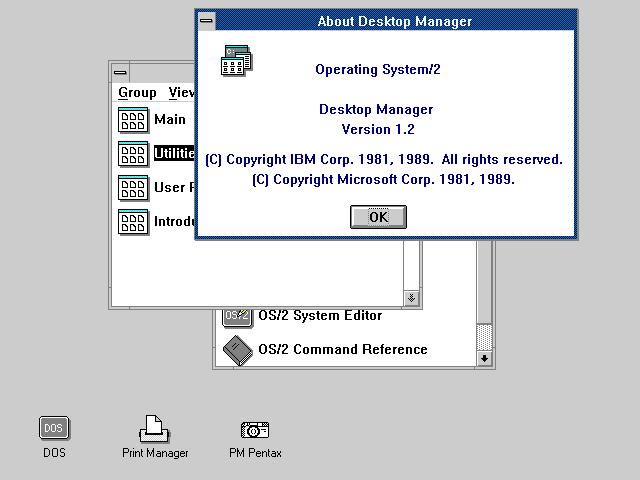
IBM's OS/2 1.2 also came with a set of tutorial programs for the EE components
as well as for the base OS. Here's what the tutorials looked like:
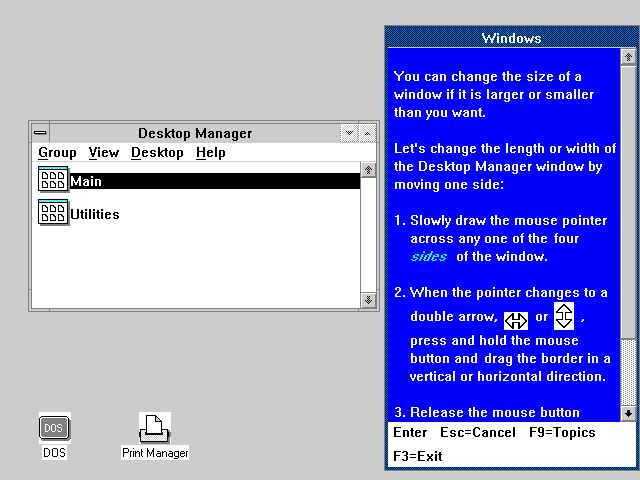
I believe MS OS/2 did not include any tutorial program but I couldn't verify
that, not having access to MS OS/2 1.2.
The similarity between OS/2 1.2 and Windows 3.0 was really striking. In case
you already forgot what Windows 3.0 looked like, here's a reminder:
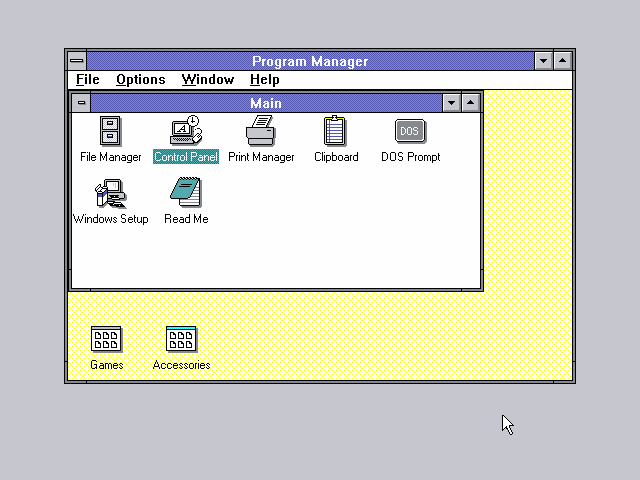
The color scheme was very similar and some of the icons were identical, as well
as the fonts. The big difference between OS/2 and Windows was that Windows 3.0 ran
on top of DOS and in fact could even run inside the OS/2 1.2 compatibility box (the
Windows 3.0 README describes this). The other difference was that Windows came with
a vast array of drivers compared to OS/2 as well as a wide range of applets (mostly
useless, except for Solitaire of course). OS/2 was much more businesslike and felt
somewhat bare in comparison.
Compared to OS/2 1.3, version 1.2 really wasn't very interesting. The feature
set was nearly identical as well as the visual appearance. So let's leave OS/2 1.2
behind and delve further into the past, where OS/2 1.1 looms large.
The first interesting fact/rumor is that in late 1989, after learning Microsoft's
plans for Windows and (non-plans) for OS/2, Jim Cannavino (head of the Personal
Systems division at IBM) proposed to kill OS/2 and buy a 40% stake in Microsoft,
after determining that the future of OS/2 looked bleak. IBM's CEO John Akers (lucky
for us) refused, and one good reason was that IBM had serious doubt the FTC (Federal
Trade Commission) would approve of that. So instead, IBM decided to "fix"
OS/2 and compete head on with Microsoft. In fact FTC tried to accuse IBM and Microsoft
of collusion after they announced in 1989 that IBM's OS/2 would cover the high end
market and Microsoft Windows the low end. This accusation was soon revealed as completely
unsubstantiated after the Microsoft - IBM "divorce" in 1990 (and then
the FTC concentrated its attention solely on Microsoft).
The other somewhat shocking piece of information is that in 1987-1988 Microsoft
really was seriously behind OS/2 and wanted to kill Windows. Windows 2.0
would be finished as a platform for Excel but no new versions would be developed.
But then some enterprising Microsoft programmers "secretly" converted
Windows to run in protected mode as their own pet project and after showing the
results to Steve Ballmer and Bill Gates, it was decided to continue the development
of Windows. When Windows 3.0 turned out to be a hit in 1990, Microsoft decided that
they didn't want to split their profits with anyone else after all and dumped IBM.
I am not trying to claim that any of the above is true. I personally think it
doesn't sound too unlikely but I'm not going to try to convince anyone.
Presentation Manager was codenamed Winthorn (you can hear Windows there) and
I believe it was developed primarily at the IBM Hursley Labs in UK. It was a cross
between Microsoft Windows and IBM's mainframe graphical system (GDDM). The programming
paradigm strongly resembled Windows - just like Windows it was message based and
many of the messages were even identical. But there was a number of significant
differences as well:
This could be a conspiracy on Microsoft's part - but I find the explanation given
in Barbarians Led by Bill Gates much more credible: Microsoft programmers
started writing Windows versions of Word and Excel (remember, Mac versions had existed
before that) around 1986-7. At the time they were expected to begin working on OS/2
versions, the Windows versions were nearly done. They simply refused to throw out
all they had and rewrite the applications for PM. And when they finally got around
to the PM versions, it was already too late. No conspiracy, just a simple lack of
organization and clear strategy which happened to work in Microsoft's favor. One
proof of the disorganization at Microsoft is that Microsoft's languages division
was 100% behind OS/2 - all the "professional" Microsoft compilers (assembler,
C, Pascal, FORTRAN, BASIC, COBOL) released between 1988 and 1991 fully supported
OS/2 (even if the entry level "Quick" versions were DOS only). Similarly
Microsoft's networking efforts were based largely on OS/2 and after abandoning OS/2,
Microsoft had no network server software and had to continue selling OS/2 1.3.
But I digress again (can't help it, sorry) and I'd better get back on topic.
On the non-GUI side OS/2 1.1 finally implemented named pipes (a mechanism of interprocess
communication) which didn't make it into OS/2 1.0. Also added was support for "large"
FAT volumes - OS/2 1.0 only supported 32MB volumes just like versions of DOS before
4.0. The "BigFAT" support in OS/2 1.1 could handle volumes up to 2GB in
size.
The flavor of OS/2 1.1 I played with was an OEM version (Zenith) of Microsoft
OS/2. It came on five 3.5" HD floppies. My test machine was the same as for
OS/2 1.2 and I also had the same problem with KBD01.SYS crashing which I fixed in
an almost identical manner. For some reason OS/2 1.1 did not work with a Matrox
G400 card (the monitor was getting out of sync) but worked fine with the ATI Rage
128 AGP.
The GUI in OS/2 1.1 would certainly not win any beauty contest - one reason was
perhaps that it was designed with old graphics cards like CGA in mind. The look
and feel strongly resembled Windows 2.x. After bootup the users were greeted with
this screen:
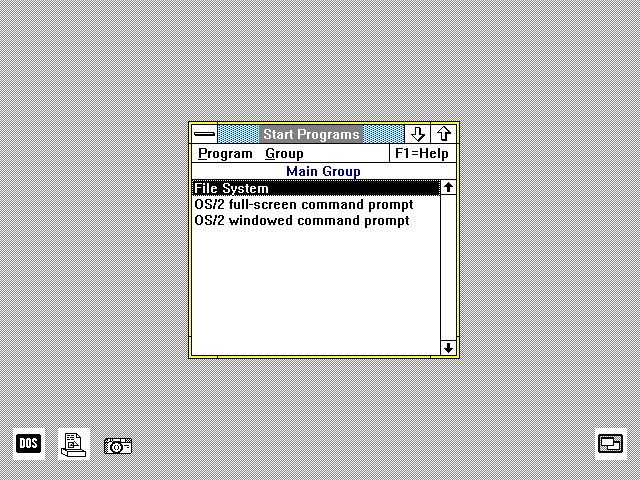
You can see the DOS session icon in the lower left corner, next to the Print
Manager icon. Note that OS/2 1.1 only supported monochrome icons (1.2 fixed that).
The icon in the lower right hand corner is the minimized Task Manager.
The third icon on the left is my own creation:
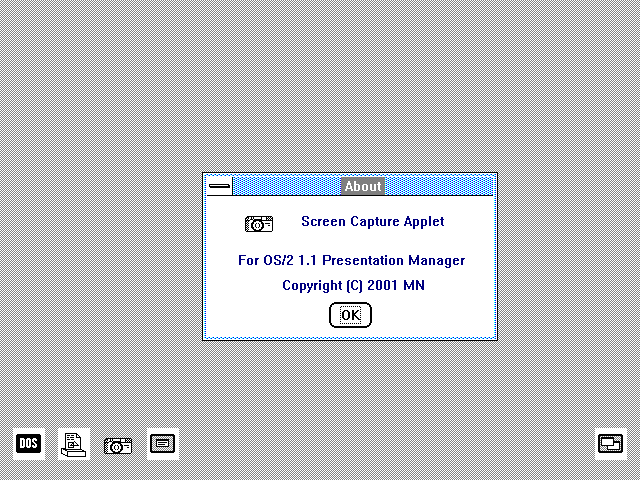
The PM Camera program I used to get OS/2 1.3 screenshots unfortunately crashed
under OS/2 1.1 (and 1.2 as well actually). A brief search for an 1.1-compatible
alternative came up with nothing (no big surprise there), so I decided to spend
a little while and write some quick and dirty utility on my own. I used a sample
program from Charles Petzold's book Programming The OS/2 Presentation Manager
(this book was written for OS/2 1.1) as a basis and then considerably extended it
(primarily to allow hot key activation and saving of the captured bitmaps). I must
say that next to the Print Manager icon, which appears to be drawn by a 5-year-old,
my "screen captor" icon (I called the program PM Pentax after my real-world
camera) looks positively slick - or at least drawn by a 10-year-old. I strongly
suspect that my screen capture applet will be the last program ever written for
OS/2 1.1.
The really neat thing about the PM Pentax program though is that it works
well on anything from OS/2 1.1 (model 1988) up to OS/2 4.5 (model 2000). It has
no problem capturing 16-color 640x480 desktop and flawlessly handles a 1280x1024
high color desktop as well. I find that pretty amazing. It sounds almost as if someone
put some forethought into designing the Presentation Manager.
For comparison, here is what Windows 2.1 looked like:
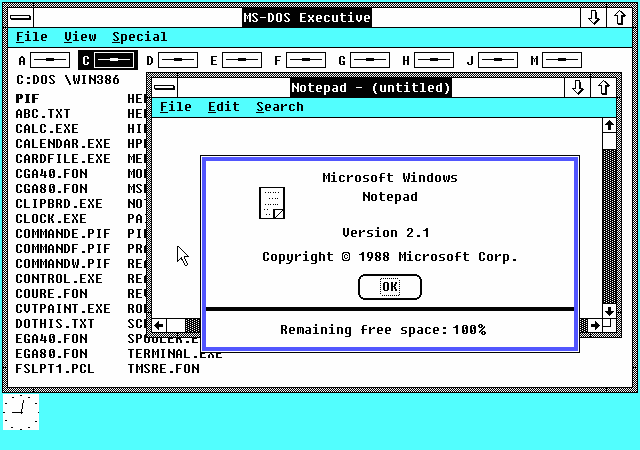
Although it is hard to believe, Windows 2.1 used even uglier color scheme than
OS/2 1.1. I find the background color really ghastly. But you can see that all the
GUI controls were very similar or identical to the ones used in Presentation Manager.
No wonder given that both GUIs were worked on by Microsoft.
Anyway on to more screenshots. Similarly to the later versions, OS/2 1.1 provided
a File Manager program:
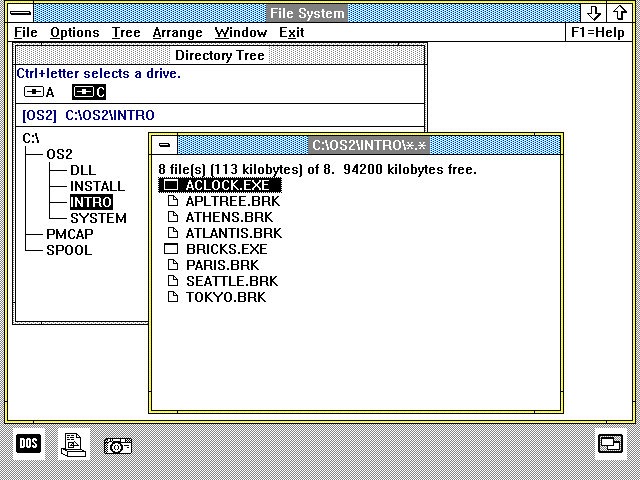
As you can see, it was not appreciably different from the File Manager supplied
with the later versions of OS/2 1.x. Similarly the Control Panel was almost identical
to the 1.2 and 1.3 versions, only it used the uglier GUI controls:
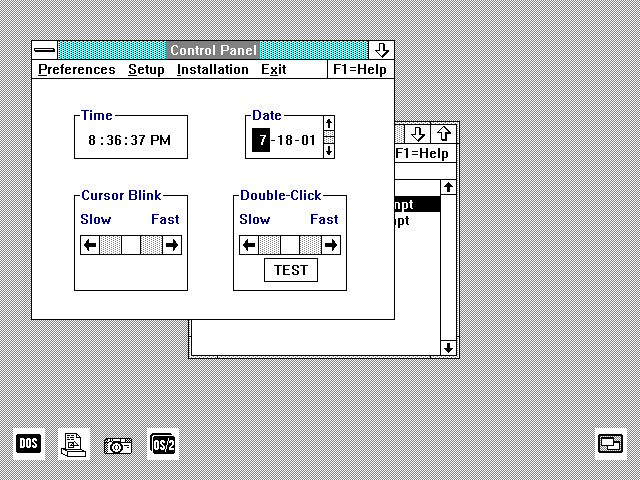
OS/2 1.1 was even equipped with some online help (invoked by hitting F1 no less!),
but the help viewer was not the same as the Information Presentation Facility introduced
in OS/2 1.2 and not nearly as helpful (no search capability for instance):
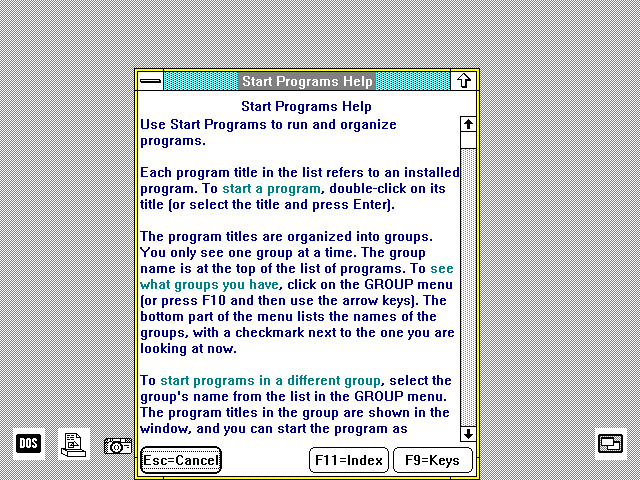
There were no online books supplied with OS/2 1.1. That had to wait for 1.2.
As is obvious by now, OS/2 1.1 was pretty boring. There were two "demonstration"
programs included - perhaps with the intent to make it a little less boring. One
of them was a simple alarm clock:
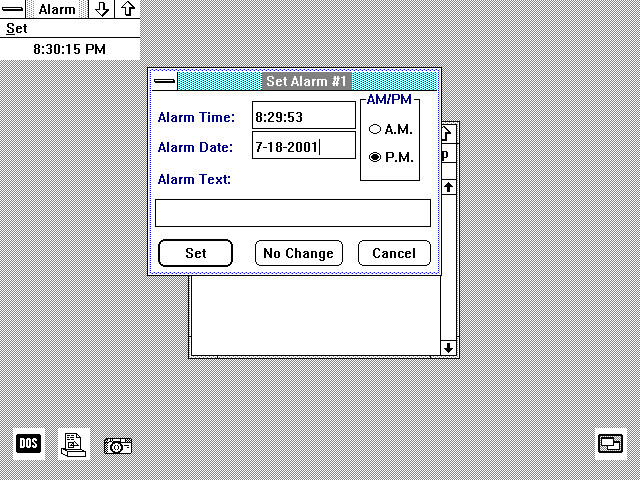
As you can see, it was not terribly fancy. It was probably designed to show off
some PM capabilities such as the GUI controls and timers. That seems trivial today
but certainly wasn't in 1988, when DOS was still the king of the IBM-compatible
world.
The only really nice looking program was the other demo program, called Microsoft
Bricks:
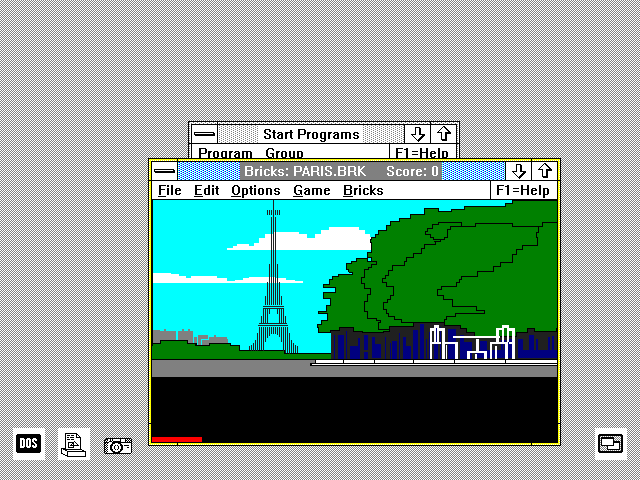
It was a GUI clone of the classic Breakout game. It came with several background
"brick walls" to make it more interesting. What unfortunately totally
spoiled it for me was the fact that it was way too fast on the 300 MHz machine
(it was written at a time when a 20 MHz machine was very high end). Or maybe
I'm just getting old and my reflexes aren't what they used to be, it's hard to tell.
Strangely enough, OS/2 1.1 did not come with a GUI editor, not even a
simple Notepad-like one. It did come with an editor however - it was called E.EXE
but only ran in fullscreen text mode and slightly resembled TEDIT:
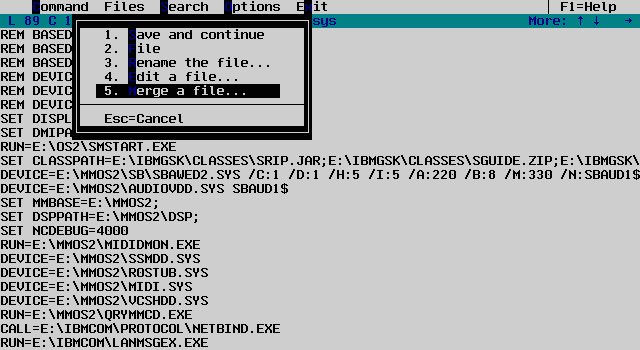
At any rate OS/2 1.1 was a very interesting piece of software technically, if
not visually. I believe it was much more advanced than any other operating system
available for personal computers at that time. Both Windows and MacOS were certainly
no match for it technically - neither had features like preemptive multitasking,
multithreading or virtual memory.
But in the end, it's not the technical merits that matter. OS/2 1.1 certainly
had drawbacks too. It supported the major graphics hardware standards (CGA, EGA,
VGA) but beyond that the support was rather thin. Printer support was pretty pathetic
- OS/2 1.1 only supported a few IBM printers and plotters and that was it. No HP,
no Epson, nothing like that. For some strange reason, certain things haven't changed
much since then...
Also the resource requirements of OS/2 1.1 were considered fairly heavy for the
time. The recommended amount of RAM was 3MB - that was certainly a lot when most
PCs had one or two MB. Plus it gobbled up about 8 megabytes of disk space - again,
a lot at a time when 40MB harddisks were considered large.
But just like with the other versions, OS/2 1.1 found some happy users. Few of
them have been running OS/2 ever since (not me, I met OS/2 much later, only after
suffering Windows for a while).
The "seed" for my screen capture program was one of sample programs
from the book Programming The OS/2 Presentation Manager by Charles Petzold,
published by Microsoft Press in 1989.
My thanks go to the OS/2 old-timers and not-so-old-timers who provided me with
stuff to write about. They are John Martin Alfredsson (Sweden), James E. Burke,
Jr. (USA), Vitus Jensen (Germany), David W. Noon (USA), Paul Ratcliffe (UK), Nino
Solazzo (Italy?) and Illya Vaes (The Netherlands) - if I have forgotten anyone I
sincerely apologize. OS/2 has apparently found followers all around the globe. Special
thanks go to Marc L Cohen for providing some interesting insider information.
Barbarians Led by Bill Gates was written by Jennifer Edstrom (daughter
of Pam Edstrom of Waggener Edstrom, Microsoft's PR firm) and Marlin Eller (an ex-Microsoft
programmer, one of the original Windows developers). This book was published by
Henry Holt in 1998. Interestingly enough, this book has been accused of being both
pro-Microsoft and anti-Microsoft, which in my opinion greatly increases the probability
that it is true.
The Microsoft File: The Secret Case Against Bill Gates was written by
Wendy Goldman Rohm and published by Random House in 1998 (was 1998 a bad year for
Microsoft or what?). This book quite obviously wasn't written to further the glory
of Bill Gates and Microsoft and spills many of the dirty little secrets.
All this information is accurate to my knowledge. I never actively used OS/2
1.x, hence there are bound to be omissions or errors in the text. If you were around
in the 1.x days and have some extra information (or some interesting old software),
I will welcome any comments at<MichalN@prodigy.net>.